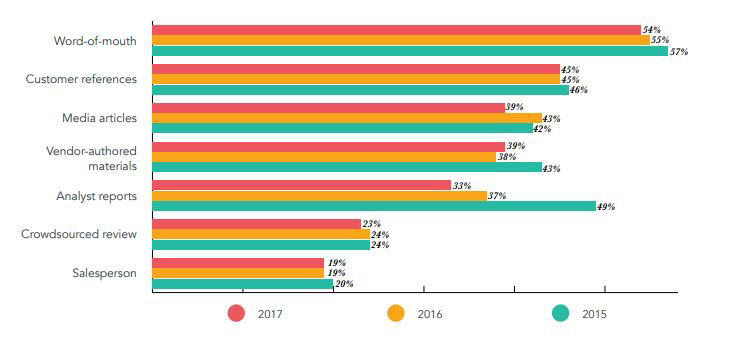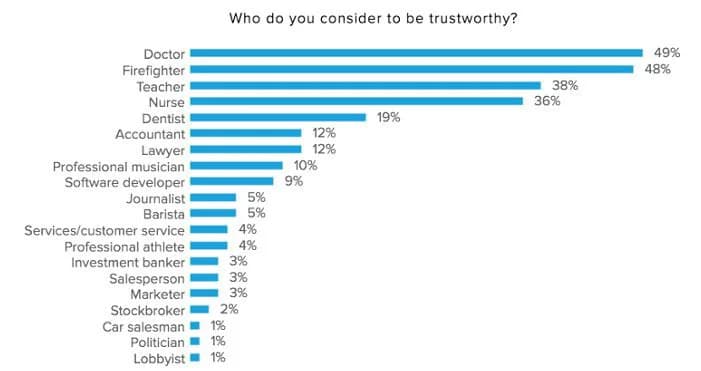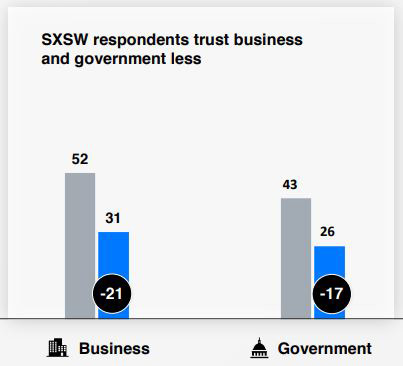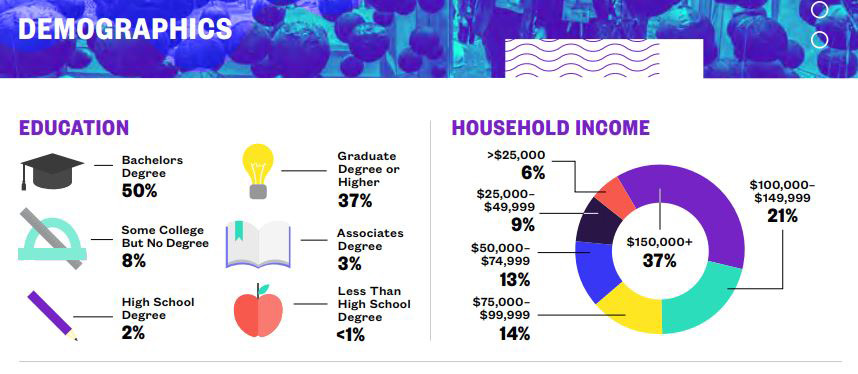Written By:
Tim Stobierski
Trust: In marketing, as in relationships, it’s one of the most important ingredients for success. Brands that engender trust in their customers and potential customers are more likely to close sales, earn new business, and retain existing business, especially when compared against brands seen as inherently untrustworthy.
Long story short, it pays to build trust.
But according to HubSpot’s 2017 State of Inbound Report, consumers don’t really trust brands. Vendor-authored materials (that is, material created by brands trying to sell) rank pretty low in terms of trust, and that salespeople themselves top the bottom of the chart, with just 19 percent of respondents saying that they find salespeople trustworthy.

And back in 2016, HubSpot found that marketers and salespeople fall near the bottom of the list of professions that people trust, below even lawyers and bankers! Youch!

This information is supported by another recent survey, this one conducted by the 2018 SXSW conference. According to the results of that survey, trust in Business (with a capital B) is on the decline. Only 52 percent of the general population sees Business as trustworthy, and that percentage drops to 31 percent among SXSW attendees—a whopping 21 percent lower.

SXSW attendees also trust search engines 17 percent less than the general population, and Social Media Networks 20 percent less than the general population, both of which are incredibly important channels through which brands acquire customers.
Why Should Companies Care?
SXSW attendees in and of themselves might be an exceedingly small percentage of the overall world market, but by looking at just who attends the conference we can see why these are important findings.
The people who attend SXSW tend to be relatively well-educated, affluent professionals. I.e., the kind of people that many brands and companies would love to attract. Though the number of attendees itself is small, the market that they represent is potentially huge, and brings with it a lot of purchasing power, as we can see in SXSW’s 2017 demographics report below:

When your ideal buyer doesn’t trust business as a whole, you’ve got an image problem that is in dire needs of being corrected.
Additionally, as the HubSpot data points out, even the general population doesn’t trust business in general, and especially not salespeople. That translates into a real uphill battle when it comes to closing sales and building your brand.
So What Is A Brand To Do?
Unfortunately, an individual marketer isn’t likely to have a direct impact on how society at large views the trustworthiness of business or brands in general. For that to happen, a pretty big shift is going to need to take place across all levels of business and society and, let’s be real here, that isn’t likely to be resolved any time soon.
But individual marketers can have a direct impact on whether or not potential customers find your particular brand trustworthy. All it takes to engender trust in your brand is to ensure that your brand is, well, trustworthy.
Take the Guesswork out of Inbound
Receive a detailed Inbound Marketing Strategy in 30 days or less.
And while there are many factors that play into building this trust (for example, the way your representatives act on the phone, the tone of 1-1 emails, the experience a customer gets when walking into a lobby, etc.) content plays a huge role in building trust, especially in the early stages of your relationship.
Building trust with your customers is going to take work, but the upside is huge. Once a buyer trusts your company and your brand, they’re much more likely to purchase from you and keep their business with you.
But how, exactly, can you create a brand that is viewed as trustworthy? Below, we discuss some tips for creating trustworthy content that will help brands build relationships with their potential buyers.
1. Create Valuable Content
The easiest way for a brand to build trust through content is simply to create content that provides value to the reader without expecting anything in return. “Creating value” can mean a lot of things, but what it ultimately often boils down to is this: Content that helps people achieve their goal and navigate the journey that ultimately may lead to a purchase is often the content that will have the most perceived value.
For example, if your blog post helps someone solve a problem, they tried it, and it worked, you’ve proven you know what you’re talking about.
In addition to being the content that ranks well in search and gets shared in social, this content allows a brand to showcase their expertise and help a potential buyer solve a problem, both of which go far in developing a trusting relationship.
It’s important to note that though you might make use of CTAs, etc. to lead the reader to your product or service, the content in and of itself should NOT be designed to overtly sell. (That kind of content has a role to play later in the buyer’s journey.) Most people can detect when they’re being sold to, and once they realize this, trust can be shattered.
This philosophy of “customers first” and of creating content that your buyers value and love is at the core of the inbound marketing movement.
2. Back Up Your Claims
Whenever possible, brands would be wise to do everything in their power to back up their claims. Doing so will lend authority to the content, which translates into a higher degree of trust in the reader.
Content can be validated in any of a number of ways, including through:
- Original research: Which can be especially powerful if you are relying on proprietary data that only you have access to
- Outside research: From a trusted, unbiased resource (think, the Pew Research Center) or an industry expert (such as HubSpot for marketing, or BuzzSumo for social media).
- Expert quotes: Especially if the expert is not tied to your brand, a quote or statement by them can go far in laying trust.
- Links to trusted outside sources: In addition to helping a reader dig deeper into an idea, these links play an important role in allowing a search engine to identify the relationships between your content and other content on the web, which can impact your rankings.
And, of course, if you can point to multiple sources that all support your assertion, you’ve hit a home run in terms of building trust in your content.
3. Don’t Play Games
Consumers, especially well-informed consumers, know when they’re being gamed. It’s in your best interest to just not even try. Being sketchy in your marketing, content, or general business practices will only further widen the trust gap between you and your customers.

A brand’s best bet is to aim to be as transparent as possible (without giving away proprietary secrets). Being open about your business model, how you make money, what your product/service is good for (and also what it’s not good for) will portray the image that you don’t have anything to hide. You’re on the up and up. And that serves as a subtle signal that you deserve to be trusted.
This transparency shouldn’t end with your content, though: It extend throughout your business model and business practices. This includes everything from content to sales to your crisis communication and public relations.
4. Show That You’re Human
It’s so much easier to build trust with a potential client if you’re willing to demonstrate that you are, in fact, human, and for good reason: It’s easier for people to build relationships with other people than it is for them to build relationships with brands.
And the great thing is that brands can demonstrate their human side in so many cool and interesting ways, most of which are subtle:
- Give your writers bylines on content they create: Whenever possible, shy away from crediting a piece of content to the general brand. Crediting it to the person who created it will remind the reader that there are humans behind your company, and can also go far in establishing your employees as thought leaders, which can be great for sales in and of itself.
- Don’t use stock photos: If you have the bandwidth to create original photos and video that features living, breathing team members, it will always perform better and resonate with the reader more than stock photos will.
- Don’t be afraid of video: Video can be a powerful tool in establishing a connection and building a trusting relationship with your buyers. It can be a little awkward to get used to at first, but by pushing through that awkward learning phase you’ll find that you’re more easily able to connect with your customers. And the great thing is that, thanks to new technologies like Soapbox by Wistia, anyone with a laptop can create videos easily and without expensive equipment or professional training.
In fact, Wistia is a great example of a company that embodies this advice well. In all of their content and one-on-one communication, they showcase their people, making it easier for potential buyers to start building a trusting relationship with the brand. Individual personalities shine through, becoming an extension of the brand, and forming a bedrock of trust. It also helps your brand shake off the cold, impersonal image that many people have towards business in general, as you can see in the video from Wistia below.
5. Don’t Forget About Your Existing Customers
Closing a deal, getting a signature, and receiving a check shouldn’t be the end of your process. After all, you’ve put in all of that work building trust: Why would you let all of that goodwill go to waste?
Instead, smart brands continue to nurture their customers and build trust even after they have bought into what the brand has to offer. By continuing to provide value to these customers, and ensuring that they are successful with your product or service, you can convert them into brand advocates and evangelists that can help you attract more business through referrals and testimonials, and can also lead to upselling opportunities in the future.
The Bottom Line
It’s important to remember that trust takes time to build, but can be erased in an instant. Once you’ve gone through the hard work of building trust in your potential buyers, you need to safeguard it against threat. That means keeping your content trustworthy over the life of your business. It also means ensuring that all of your other marketing efforts (email, calling, etc.) work to further develop your trust among customers.








